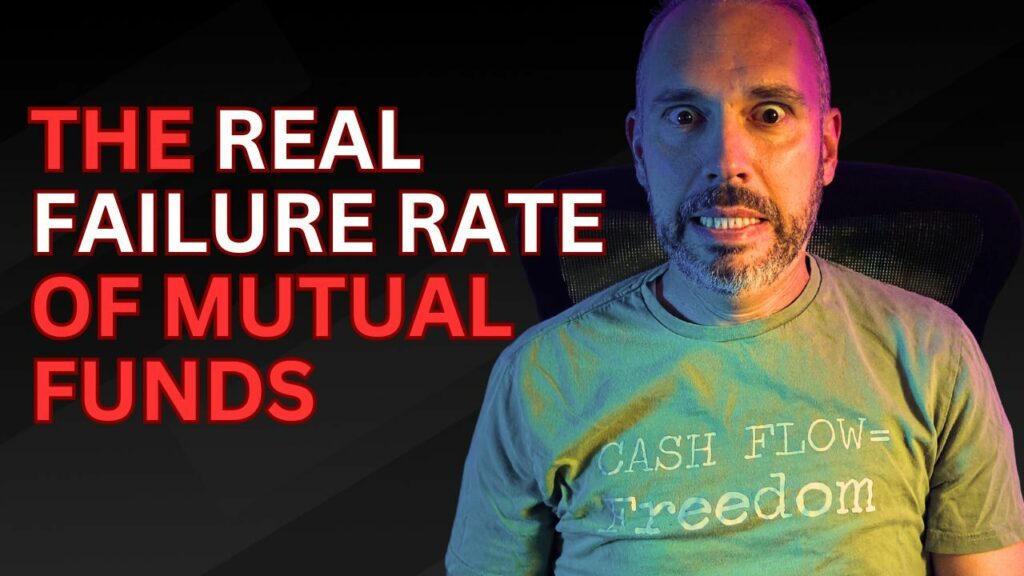👇WATCH EPISODE 👇

The Truth About Mutual Funds’ 99% Failure Rate and What Actually Works for Financial Freedom
Everyone’s been told the same thing: “Invest in mutual funds, stay the course, and you’ll be set for retirement.” But what if that’s one of the most misleading financial myths in America?
The truth is, mutual funds don’t just carry market risk they carry something far worse: a 99% failure rate when it comes to achieving real financial freedom. In this post, I’ll show you why, and more importantly, what actually works if you want your money working harder for you so you don’t have to work so hard for it.
Risk vs. Failure: What’s the Difference?
Most people think risk and failure mean the same thing. They don’t.
- Risk is the chance of loss the probability that your money could go down in value.
- Failure is the chance you won’t reach your goal in this case, having enough income to live freely without working.
A savings account has near-zero risk. You’re not going to “lose” your savings unless the world ends. But the failure rate is 100%. You’ll never become financially free just saving money at 0.01% interest.
Why Mutual Funds Don’t Work Like You Think
The same principle applies to mutual funds. Over time, you might not lose all your moneybut that doesn’t mean you’ll ever have enough to live on.
Even Fidelity, one of the biggest fund companies in the world, reports that out of 45 million accounts, only about 1 million have over $1 million saved. That’s barely 2%.
And when Transamerica surveyed those millionaires, 35% said it would take a miracle to retire. That means fewer than 1% of all Fidelity investors feel financially free.
That’s not “success.” That’s survival.
Why the failure? Because mutual funds are built for accumulation, not income. Add in inflation, taxes, and market volatility, and your “nest egg” suddenly looks more like a fragile bird’s shell.
The 4% Rule Is a Fantasy
Let’s take a practical example.
Say you’ve got $1 million in a 401(k). The financial world tells you to follow the 4% rule withdraw 4% a year so your money “lasts.”
That gives you $40,000 a year, before taxes. You’re supposed to live comfortably on that? Even if you doubled your balance to $2 million, you’re still only getting $80,000 a year and that’s taxable income that can’t keep up with inflation.
That’s not freedom. That’s a slow bleed.
So What Actually Works?
When I left traditional financial advising, it was because I couldn’t keep selling that lie. I saw too many “disciplined savers” still working in their 60s and 70s not because they wanted to, but because their plan failed them.
What does work is cash-flow investing using your money to create steady, passive income that grows independent of market performance.
Here are three approaches I compared in the episode:
1. Mutual Funds
- 10-year growth: ~$1 million from $600,000 invested
- Annual income: $30,000–$40,000 (taxable)
- Result: low risk, high failure rate
2. Whole Life Insurance (“Infinite Banking”)
- 10-year value: ~$879,000
- Annual income: ~$65,000 (tax-free)
- Result: very low risk, moderate success rate
3. Alternative Investments (10% Cash Flow)
- 10-year value: ~$1.55 million
- Annual income: ~$150,000+ (tax-advantaged)
- Result: calculated risk, high success rate
Even if 25% of your investments failed completely, you’d still be earning around $100,000 a year, far outpacing the mutual fund approach.
That’s what I call risk that pays off.
The Real Question Isn’t “What’s Safe?” It’s “What Succeeds?”
Safety without success is still failure. Mutual funds might protect you from losing all your money, but they don’t protect you from wasting your best years.
You deserve better than “hope and wait.” You deserve predictable income, real cash flow, and the ability to live life on your terms now, not 30 years from now.
The Bottom Line
There will always be risk. But when you combine the right strategies guaranteed growth through properly designed whole life policies, plus cash-flowing assets that create monthly income you minimize your downside and maximize your freedom.
That’s the kind of plan that beats the 99% failure rate of mutual funds.
